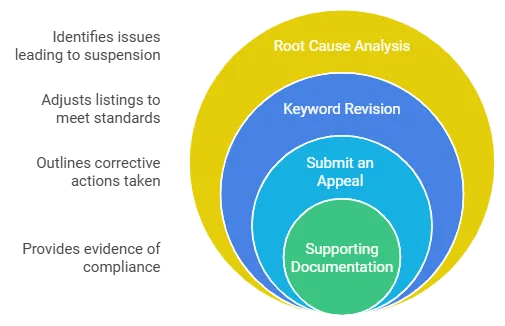How to Prevent Brand Misuse Violations on Amazon
How to Prevent Brand Misuse Violations on Amazon
Maintaining brand integrity is essential for Amazon to ensure a trustworthy shopping experience for its customers. However, sellers sometimes engage in brand misuse—an action that violates Amazon’s policies by improperly using brand names, logos, or trademarks. Such practices can lead to account suspension, listing deactivation, or even permanent account deactivation. For sellers, understanding what constitutes brand misuse and how to avoid it is critical to maintaining compliance and protecting their business.
In this article, we’ll explore what brand misuse means on Amazon, why it’s a serious issue, common violations that lead to suspensions, and strategies to avoid them. We’ll also discuss what steps to take if your account is suspended due to brand misuse violations.
What is Brand Misuse on Amazon?
Brand misuse occurs when a seller uses another brand’s name, logo, trademark, or copyrighted content without proper authorization. This can happen in various ways, such as misleading branding in product titles, unauthorized use of logos in images, or listing private-label products under well-known brand names. Amazon has strict policies to prevent brand misuse and protect the intellectual property of brand owners.
Example: A seller listing their own generic smartphone cases under a popular brand’s name to increase visibility is engaging in brand misuse. Such violations can quickly lead to listing suspension or even account deactivation.
Why Brand Misuse Leads to Account Suspensions
Amazon enforces strict guidelines to prevent sellers from misleading customers or infringing on intellectual property. Brand misuse compromises customer trust, undermines the integrity of the marketplace, and can expose sellers to legal action from brand owners. Amazon’s proactive approach to brand protection ensures that any misuse is met with immediate penalties to maintain the integrity of its marketplace.
When a seller is flagged for brand misuse, Amazon typically issues a warning or suspends the listing or account until the issue is resolved. Sellers who repeatedly violate brand guidelines may face more severe consequences, such as permanent account deactivation or legal action from the affected brands.
Common Types of Brand Misuse Leading to Suspensions
Sellers can engage in brand misuse in several ways, either intentionally or inadvertently. Here are some common scenarios that often lead to suspensions or deactivations:
1. Listing Generic Products Under a Branded Name
One of the most common forms of brand misuse is listing generic or private-label products under a well-known brand name. Sellers do this to capitalize on the brand’s popularity and attract more customers. For example, a seller might list a generic fitness tracker under the “Fitbit” brand name without any authorization, leading to an immediate suspension.
2. Unauthorized Use of Logos or Trademarks
Using brand logos or trademarks in product images or descriptions without permission is another frequent violation. For instance, displaying the Nike logo on product images when the seller isn’t an authorized distributor would be considered brand misuse. Sellers who engage in this practice risk having their listings deactivated and accounts suspended.
3. Misleading Branding in Product Titles
Using brand logos or trademarks in product images or descriptions without permission is another frequent violation. For instance, displaying the Nike logo on product images when the seller isn’t an authorized distributor would be considered brand misuse. Sellers who engage in this practice risk having their listings deactivated and accounts suspended.
4. Reselling Products as New Without Authorization
Using brand logos or trademarks in product images or descriptions without permission is another frequent violation. For instance, displaying the Nike logo on product images when the seller isn’t an authorized distributor would be considered brand misuse. Sellers who engage in this practice risk having their listings deactivated and accounts suspended.
How to Avoid Brand Misuse Violations on Amazon
To protect your account from suspension or deactivation, it’s crucial to understand and adhere to Amazon’s brand guidelines. Here are several strategies to stay compliant:
1. List Products Under Correct Brands
Only use brand names if you are authorized to sell those products. Double-check your listings to ensure all products are correctly categorized under the appropriate brand name.
2. Avoid Unauthorized Use of Logos or Trademarks
Do not use brand logos, images, or copyrighted material in your product listings unless you have explicit permission from the brand owner. If you are a reseller, obtain proper documentation to demonstrate your authorization.
3. Be Accurate in Product Titles and Descriptions
Ensure that your product titles, bullet points, and descriptions are accurate and free from misleading branding. Do not include unrelated brand names to increase search visibility.
4. Verify Brand Authorization
If you’re selling branded products, always verify that you have the necessary rights or authorization to sell them. Keep a record of invoices, letters of authorization, or agreements with brand owners to demonstrate your compliance.
What to Do If Your Amazon Account is Suspended for Brand Misuse
What to Do If Your Amazon Account is Suspended for Brand Misuse
If your Amazon account is suspended or deactivated due to brand misuse, it’s essential to act quickly to resolve the issue. Here’s a roadmap for handling reinstatement:

Example: A seller who faced suspension for using a popular brand’s logo in their product images successfully reinstated their account by removing the offending images, providing proof of authorization, and submitting a well-documented appeal. Their account was reinstated within a week after demonstrating compliance.
Frequently Asked Questions (FAQ)
Frequently Asked Questions
Frequently Asked Questions
Yes, repeated or severe violations—such as consistently listing products under incorrect brand names or using unauthorized logos—can lead to permanent account deactivation.
The timeline for reinstatement depends on the severity of the violation and the thoroughness of your appeal. Minor violations may be resolved within a few days, while more complex issues could take weeks.
If your appeal is rejected, carefully review Amazon’s feedback and address any unresolved issues. Submit a revised appeal with additional documentation or corrective measures to strengthen your case for reinstatement.
Protecting Your Amazon Business from Brand Misuse Violations
Brand misuse can have serious consequences for your Amazon business, including listing removal, account suspension, or permanent deactivation. Sellers must adhere strictly to Amazon’s brand guidelines and avoid using unauthorized brand names, logos, or trademarks. Protect your business by being accurate, transparent, and compliant in all your listings.
If your account has been suspended due to brand misuse violations, acting promptly and submitting a well-documented appeal is crucial to reinstatement. At Amazon Sellers Appeal by ASA Compliance Group, led by Or Shamosh, we specialize in helping sellers navigate Amazon’s complex compliance policies and offer expert support for reinstatement. [Contact us today] to fast-track your account’s reinstatement and keep your business running smoothly.









